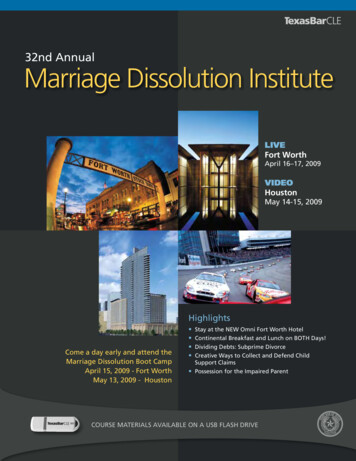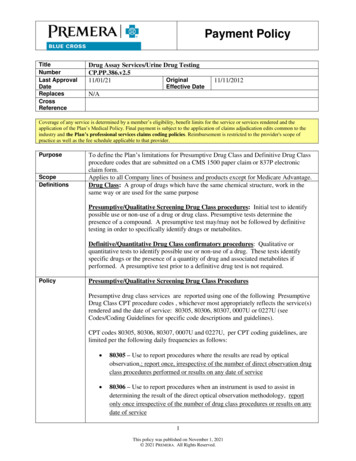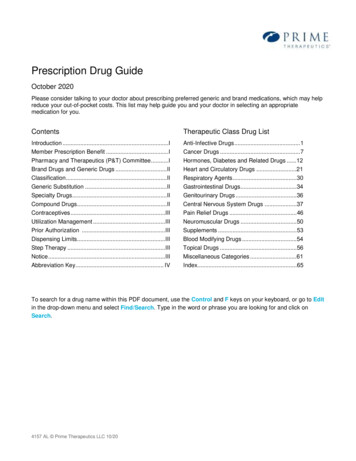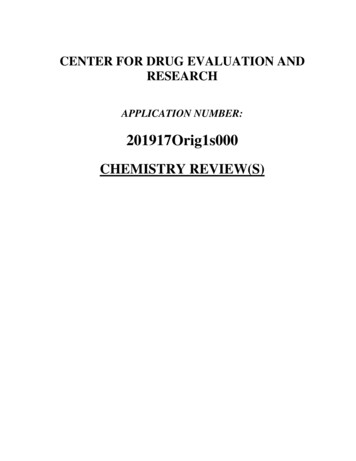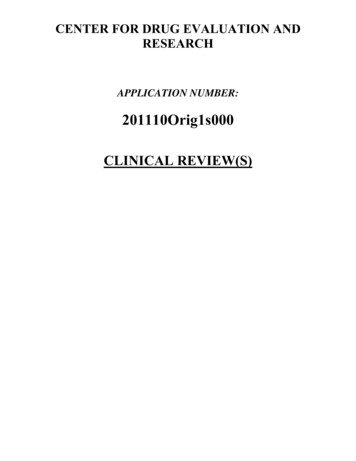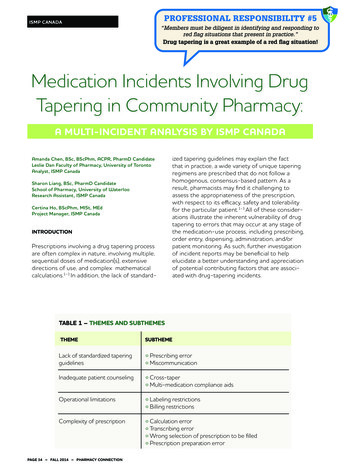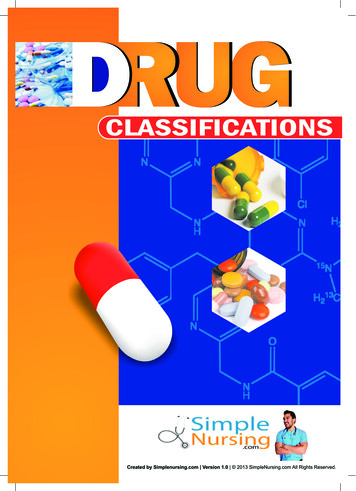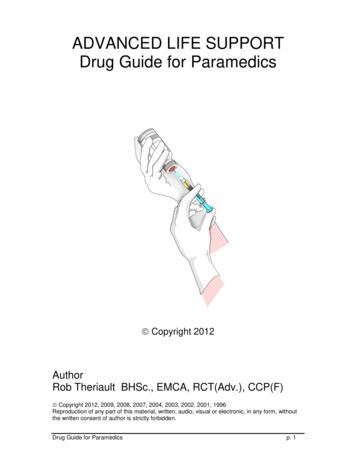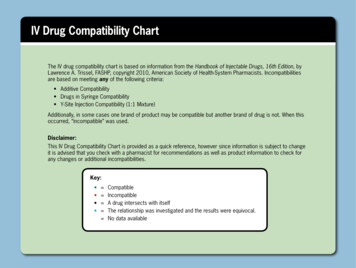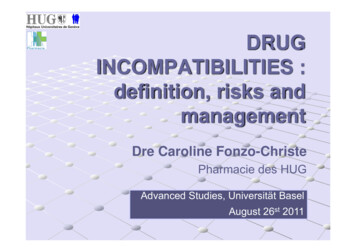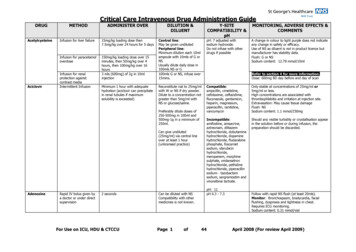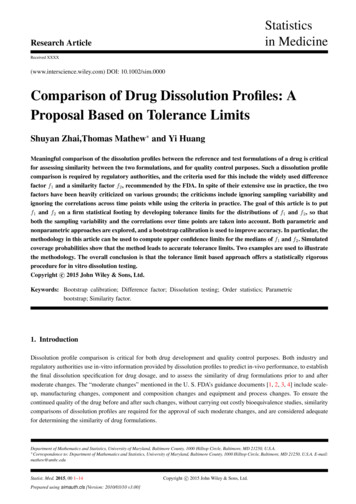
Transcription
Statisticsin MedicineResearch ArticleReceived XXXX(www.interscience.wiley.com) DOI: 10.1002/sim.0000Comparison of Drug Dissolution Profiles: AProposal Based on Tolerance LimitsShuyan Zhai,Thomas Mathew and Yi HuangMeaningful comparison of the dissolution profiles between the reference and test formulations of a drug is criticalfor assessing similarity between the two formulations, and for quality control purposes. Such a dissolution profilecomparison is required by regulatory authorities, and the criteria used for this include the widely used differencefactor f1 and a similarity factor f2 , recommended by the FDA. In spite of their extensive use in practice, the twofactors have been heavily criticized on various grounds; the criticisms include ignoring sampling variability andignoring the correlations across time points while using the criteria in practice. The goal of this article is to putf1 and f2 on a firm statistical footing by developing tolerance limits for the distributions of f1 and f2 , so thatboth the sampling variability and the correlations over time points are taken into account. Both parametric andnonparametric approaches are explored, and a bootstrap calibration is used to improve accuracy. In particular, themethodology in this article can be used to compute upper confidence limits for the medians of f1 and f2 . Simulatedcoverage probabilities show that the method leads to accurate tolerance limits. Two examples are used to illustratethe methodology. The overall conclusion is that the tolerance limit based approach offers a statistically rigorousprocedure for in vitro dissolution testing.Copyright c 2015 John Wiley & Sons, Ltd.Keywords: Bootstrap calibration; Difference factor; Dissolution testing; Order statistics; Parametricbootstrap; Similarity factor.1. IntroductionDissolution profile comparison is critical for both drug development and quality control purposes. Both industry andregulatory authorities use in-vitro information provided by dissolution profiles to predict in-vivo performance, to establishthe final dissolution specification for drug dosage, and to assess the similarity of drug formulations prior to and aftermoderate changes. The “moderate changes” mentioned in the U. S. FDA’s guidance documents [1, 2, 3, 4] include scaleup, manufacturing changes, component and composition changes and equipment and process changes. To ensure thecontinued quality of the drug before and after such changes, without carrying out costly bioequivalence studies, similaritycomparisons of dissolution profiles are required for the approval of such moderate changes, and are considered adequatefor determining the similarity of drug formulations.Department of Mathematics and Statistics, University of Maryland, Baltimore County, 1000 Hilltop Circle, Baltimore, MD 21250, U.S.A. Correspondence to: Department of Mathematics and Statistics, University of Maryland, Baltimore County, 1000 Hilltop Circle, Baltimore, MD 21250, U.S.A. E-mail:mathew@umbc.eduStatist. Med. 2015, 00 1–14Prepared using simauth.cls [Version: 2010/03/10 v3.00]Copyright c 2015 John Wiley & Sons, Ltd.
Statisticsin MedicineS. Zhai,T. Mathew and Y. HuangA dissolution profile captures the percentage of the active drug ingredient dissolved (based on one dosage unit) atmultiple pre-specified time points. A general dissolution comparison contains two or more drug formulations to becompared, and on each formulation at least six profiles are obtained from one or more lots in a batch. The numberof sampling time points may vary from drug to drug, affected by the speed of dissolution of the active drug ingredient1K 01K 0[1, 2, 3, 4]. Let YR,i (YR,i, ., YR,i) , i 1, ., nR , and YT,j (YT,j; .; YT,j) , j 1, ., nT , be the observed dissolutionprofiles for the ith and j th dosage units from the reference and test formulations, respectively, where K denotes the numberof pre-specified time points. Let ȲR (ȲR1 , ȲR2 , ., ȲRK )0 and ȲT (ȲT1 , ȲT2 , ., ȲTK )0 denote the sample mean profiles forthe reference and test drugs, respectively. The two criteria commonly used and recommended by the FDA for dissolutionprofile comparison [5] are:KPDifference factor: f1 t 1 ȲRt ȲTt KPt 1 100%ȲRt "Similarity factor: f2 K1 X50 log10 1 wt (ȲRt ȲTt )2K# 0.5 100 ,(1)t 1where the wt ’s are the pre-specified weights, often set to 1 (the weights are set to 1 throughout this paper). The FDAguidance document [1] indicates that f1 values less than 15 (i.e., 0-15) and f2 values greater than 50 (i.e., 50-100) maybetaken as evidence to conclude the equivalence of the dissolution profiles of the test and reference products. Notice thatf1 0 and f2 100 for two identical dissolution profiles [1, 2, 3, 4].In spite of their popularity, f1 and f2 have quite a few limitations [6]. First, f1 is very sensitive to the choice of referencelots. Simply interchanging the roles of reference and test batches will change the value of f1 in general, even though thesimilarity evaluation should not be affected. As a result, f2 is more popular in practice. Secondly, both of them are sensitiveto K - total numbers of time points, especially when both dissolution profiles level off. FDA sets clear guidance on thetotal number of time points for different types of drugs, in order to address such concerns. Third, f1 and f2 don’t takeinto consideration the correlation among the repeated dissolution measures across times. Finally, the similarity evaluationusing f1 and f2 ignores the sampling variability in the data. A critical evaluation of the factor f2 is provided in the paperby [7].Both model-independent methods and model-dependent methods have been developed for dissolution comparisons toaddress the last two concerns [6]. Here the term “model dependent” refers to the use of appropriate models for the meanvectors of the dissolution profiles, modeled as a function of time. Models used for this purpose include the exponentialmodel, Probit model, Gompertz model, Logistic model and Weibull Model; the Weibull model has been noted to providea good fit for the mean vectors [8, 9, 10]. A population version of f2 is considered in [11]; the authors modified f2 byreplacing ȲRt and ȲTt in (1) with the corresponding population mean vectors, so that the criteria are unknown parametricfunctions, and then discussed hypothesis testing procedures for dissolution comparison [11, 12, 13, 14].Our purpose is to develop procedures for dissolution comparisons based on the criteria f1 and f2 in (1) by takinginto account simultaneously both the sampling variability and the correlations across multiple time points. Since drugresponses from individual subjects are of interest in practice, we shall consider criteria similar to f1 and f2 by replacingȲR and ȲT by the respective individual response vectors YR and YT , respectively. Indeed, [5] suggested such criteria based2www.sim.orgPrepared using simauth.clsCopyright c 2015 John Wiley & Sons, Ltd.Statist. Med. 2015, 00 1–14
Statisticsin MedicineS. Zhai,T. Mathew and Y. Huangon individual responses. We shall denote the resulting criteria by g1 and g2 , defined asKPg1 t 1 YRt YTt KPt 1 100%YRt "g2K1 Xwt (YRt YTt )2 50log10 1 Kt 1 # 0.5 100 K 1 X50 log10 [1 X] 0.5 100 , where X wt (YRt YTt )2 .K(2)t 1Note that both g1 and g2 are random variables. Furthermore, the similarity factor g2 is large if the quantity X definedin (2) is small. Thus, in the context of the similarity factor g2 defined above, estimating a cutoff point below which aspecified percentage or more of the X distribution will fall (with a given confidence level) can be used to assess dissolutionsimilarity. Such an upper cutoff value (to be estimated using a random sample) is referred to as an upper tolerance limitfor the distribution of X . If X̂U is an upper tolerance limit for X , then a lower tolerance limit, say ĝ2L , for the distributionof g2 is given by: ĝ2L 50 log10 [1 X̂U ] 0.5 100(3)If ĝ2L is large (say, greater than 50 according to the FDA guideline), then the g2 distribution is mostly above 50, witha certain confidence level. If so, we conclude that the dissolution profiles across the test and reference populations aresimilar. In Section 2, our tolerance limit method is described in the context of g2 . A similar approach can be adoptedfor the difference factor g1 given in (2), and also for the factors f1 and f2 given in (1). It should be noted that we havedeveloped our methodology in a parametric set up, assuming multivariate normality, and in a non-parametric set up,without making any distributional assumption. Section 3 presents simulation studies on the accuracy of our proposedapproaches. Simulated coverage probabilities show that our methodology is accurate in the parametric as well as nonparametric set ups. Section 4 presents two real applications based on published dissolution profile data. Conclusions anddiscussions appear in Section 5. Since the computation of a tolerance limit uses the actual population distribution, thevariability in the population distribution is taken into account, together with the correlations across different time points.Furthermore, the sampling variability is also taken into account through the use of an associated confidence level. In otherwords, our approach offers a rigorous method for assessing dissolution profile similarity, based on criteria currently inuse. In particular, our methodology can be used to compute an upper confidence limit of the median of each of the randomvariables g1 , g2 , f1 and f2 .We conclude this introductory section with two observations. First of all, the methodologies used in our work arenot new; we have used two existing methodologies, namely, non-parametric tolerance limit computation and bootstrapcalibration, in order to develop a statistically valid approach for dissolution profile comparison based on criteriarecommended by the FDA. As already noted, such an approach has been lacking, in spite of the widespread use of the FDArecommended criteria. Secondly, our methodology may appear somewhat cumbersome to understand and implement; seethe computational steps in Algorithm 2 and Algorithm 4 in the next section. However, this should not be a hinderance inpractical applications, since we have developed the necessary R code, available online as supporting material.2. Tolerance limits for dissolution profile comparisonsBy definition, an upper tolerance limit for the distribution of X defined in (2) is a limit computed from a random sample,so that a proportion p or more of the distribution of X is below the limit, with a given confidence level, say 1 α. TheStatist. Med. 2015, 00 1–14Prepared using simauth.clsCopyright c 2015 John Wiley & Sons, Ltd.www.sim.org3
Statisticsin MedicineS. Zhai,T. Mathew and Y. Huangquantity p is referred to as the content of the one-sided tolerance interval, whose upper limit is the upper tolerance limit.Furthermore, the confidence level 1 α reflects the sampling variability, since the tolerance limit is computed using arandom sample. It is well known that an upper tolerance limit for X , having content p and confidence level 1 α, issimply a 100(1 α)% upper confidence limit for the pth percentile of X (Chapter 1, [15]). An upper tolerance limit canbe computed parametrically or non-parametrically, and the latter is based on order statistics. Even though we are in aparametric set up, we face several difficulties when it comes to computing an upper tolerance limit for the distribution ofX . First of all, neither the distribution of X , nor its percentile, is available in a closed form. Even if we are to ignore theparametric assumption, and decide to compute a non-parametric upper tolerance limit for X , we face the difficulty thata sample is not available from the distribution of X ; samples are available from YR N (µR , ΣR ) and YT N (µT , ΣT )and X is a function of YR and YT . In order to circumvent these difficulties, we proceed as follows. Based on samplesYRi , i 1, 2, ., nR , and YT i , i 1, 2, ., nT from N (µR , ΣR ) and N (µT , ΣT ), respectively, obtain estimates ofthe unknown parameters µR , ΣR , µT , and ΣT , and denote the estimates by µ̂R , Σ̂R , µ̂T , and Σ̂T , respectively. Now generate B parametric bootstrap samples consisting of pairs (YRj, YT j ) as YRj N (µ̂R , Σ̂R ) and YT j N (µ̂T , Σ̂T ), j 1, 2, ., B , where the YRj s and the YT j s are generated independently. However, note that we are pairing them. NowKP t t we let Xj K1wt (YRj YT tj )2 , j 1, 2, ., B , where YRjand YT tj are the tth components of the vectors YRjt 1and YT j , respectively (t 1, 2, ., K ). In order to compute a non-parametric upper confidence limit having contentp and confidence level 1 α, we proceed using standard methodology as explained in Chapter 8 of [15]. Thus considerW Binomial(B, 1 p), and let k be the largest integer satisfying P (W k) 1 α. We then select the (B k 1)thorder statistic among the Xj as our upper tolerance limit for the distribution of X . However, we don’t expect the resultingupper tolerance limit to be accurate, since the sample used is a parametric bootstrap sample, and is not a sample from thedistribution of X . In order to correct for this, we use a bootstrap calibration on the content p, and this finally providesthe desired upper tolerance limit. The bootstrap calibration requires an estimate of the pth percentile of the distributionof X , which is not available in an analytic form. We shall however use an efficient approximation due to [16]; see theAppendix. Algorithm 1 and Algorithm 2 given below provide the steps necessary to implement the process just describedfor computing an upper tolerance limit. Algorithm 1 describes the computation of the non-parametric upper tolerance limitbased on a parametric bootstrap sample, and Algorithm 2 explains the bootstrap calibration. We refer to [17], Chapter 18,for an explanation of the bootstrap calibration idea.Algorithm 1 (Parametric bootstrap upper tolerance limit)1. From the original samples YRi , i 1, 2, ., nR , and YT i , i 1, 2, ., nT , compute the unbiased estimates of themean vectors µR and µT , and the covariance matrices ΣR and ΣT asnRX1(YRi ȲR )(YRi ȲR )0 ,µ̂R ȲR , µ̂T ȲT , Σ̂R nR 1i 1nTX1and Σ̂T (YT i ȲT )(YT i ȲT )0 ,nT 1i 1where ȲR and ȲT are the respective sample mean vectors. Then11µ̂R N (µR ,ΣR ), µ̂T N (µT ,ΣT ),nnT R 11Σ̂R WK nR 1,ΣR , and Σ̂T WK nT 1,ΣT ,nR 1nT 1where Wr (m, Σ) denotes the r dimensional Wishart distribution with df m, and scale matrix equal to Σ. 2. Generate parametric bootstrap samples of size B each: YRj N (µ̂R , Σ̂R ), and YT j N (µ̂T , Σ̂T ), j 1, 2, ., B .4www.sim.orgPrepared using simauth.clsCopyright c 2015 John Wiley & Sons, Ltd.Statist. Med. 2015, 00 1–14
Statisticsin MedicineS. Zhai,T. Mathew and Y. Huang 1 2 K 00 Write YRj (YRj, YRj, ., YRj) , YT j (YT1 j , YT2 j , ., YTK j ) , and compute Xj 1KKPt (YRj YTt j )2 , j 1, 2,t 1., B .3. Let W Binomial(B, 1 p), and let k be the largest integer satisfying P (W k) 1 α.4. The (B k 1)th order statistic among the Xj s is then an upper tolerance limit for the distribution of X KP1(YRt YTt )2 .Kt 1Algorithm 2 (Bootstrap calibration on the content p):1. Let X̂p denote an estimate of the pth percentile of X ; see the Appendix for its computation.2. Generate a bootstrap sample of size B1 parametrically from the distributions of µ̂R , Σ̂R , µ̂T , Σ̂T :µ̂ Ri N (µ̂R , n1R Σ̂R ), µ̂ T i N (µ̂T , n1T Σ̂T ), Σ̂ Ri WK nR 1, nR1 1 Σ̂R and Σ̂ T i WK nT 1, nT1 1 Σ̂T , i 1, 2, ., B1 .3. For each i 1, 2, ., B1 , generate B2 second level bootstrap samples as follows: YR,ij N (µ̂ Ri , Σ̂ Ri ), and YT,ij N (µ̂ T i , Σ̂ T i ), j 1, ., B2 . 1 2 K 0 1 2 K 0Write YR,ij (YR,ij, YR,ij, ., YR,ij) , YT,ij (YT,ij, YT,ij, ., YT,ij) and compute XijK1 X t t 2(YR,ij YT,ij) , j 1, ., B2 , i 1, ., B1 . Kt 14. Select s content values p1 , p2 , ., ps . For l 1, 2, ., s, let Wl Binomial(B2 , 1 pl ), and let kl be the largest integer satisfying P (Wl kl ) 1 α. For each i 1, 2, ., B1 , let Xi,(Bdenote the (B2 kl 1)th order2 kl 1) statistic among the Xij (j 1 , 2, ., B2 ). 5. For each pl , obtain the proportion of times (out of B1 ) that X̂p Xi,(B.2 kl 1)6. Among all the pl ’s, determine the value that makes the above proportion closest to 1 α; denote this value as p̂0 .7. Now implement Algorithm 1 using the content value p̂0 .Our method involves extensive use of the bootstrap, along with bootstrap calibration, and Algorithm 1 and Algorithm 2provide a summary of the methodology under the multivariate normality assumption. However, the multivariate normalityassumption of YR and YT may not always hold, in which case the parametric bootstrap algorithms are not appropriate.Instead, the bootstrap should be carried out non-parametrically for computing an upper tolerance limit for the distributionof the quantity X in (2). It should however be noted that for implementing the bootstrap calibration, it is necessary to havean estimate of the pth percentile of the distribution of X . Such an estimate can also be obtained using the bootstrap appliedto the dissolution profile samples of sizes nR and nT , obtained for the reference drug and the test drug, respectively. Forthis, we proceed as follows. Let YR and YT represent observations selected with replacement from the dissolution profilePKsamples of sizes nR and nT , and compute X K1 t 1 (YTt YRt )2 . Repeat this many times, generating several valuesof X . The pth percentile of the X values so obtained is an estimate of the pth percentile of the distribution of X . Weshall once again use the notation X̂p to denote the estimate so obtained. Here are the modified versions of Algorithm 1and Algorithm 2, when the bootstrap is implemented non-parametrically:Algorithm 3 (Non-parametric bootstrap upper tolerance limit): 1. Select B pairs of observations YRjand YT j randomly with replacement from the dissolution profile samples of 1 2 K 0sizes nR and nT for the reference drug and the test drug, respectively. Write YRj (YRj, YRj, ., YRj) andPK1 1 2 K 0 t t 2YT j (YT j , YT j , ., YT j ) , and compute Xj K t 1 (YT j YRj ) , j 1, 2, ., B .2. Let W Binomial(B, 1 p), and let k be the largest integer satisfying P (W k) 1 α.Statist. Med. 2015, 00 1–14Prepared using simauth.clsCopyright c 2015 John Wiley & Sons, Ltd.www.sim.org5
Statisticsin MedicineS. Zhai,T. Mathew and Y. Huang3. The (B k 1)th order statistic among the Xj s is an upper tolerance limit for the distribution of X 1KKPt 1(YRt YTt )2 .Algorithm 4 (Calibration on the content p):PK1. Let X̂p denote the non-parametric estimate of the pth percentile of X K1 t 1 (YTt YRt )2 , computed as describedearlier.2. Non-parametrically generate B1 bootstrap samples, each of size nR drawn with replacement from the given dissolution profile sample of sizes nR for the reference drug. Denote these B1 samples by YRi1, YRi2, ., YRin,Ri 1, 2, ., B1 . Similarly generate B1 bootstrap samples, each of size nT drawn with replacement from the givendissolution profile sample of sizes nT for the test drug. Denote these by YT i1 , YT i2 , ., YT inT , i 1, 2, ., B1 . 3. For each i 1, 2, ., B1 , generate B2 pairs of observations: (YR,ij, YT,ij), j 1, 2, ., B2 , where the YR,ij’s are selected with replacement from YRi1 , YRi2 , ., YRinR , and the YT,ij ’s are selected with replacement from YT i1 , 1 2 K 0 1 2 K 0YT i2 , ., YT inT . Write YR,ij (YR,ij, YR,ij, ., YR,ij) , YT,ij (YT,ij, YT,ij, ., YT,ij) and compute Xij K1 X t t 2) , j 1, ., B2 , i 1, ., B1 .(YR,ij YT,ijKt
multiple pre-specified time points. A general dissolution comparison contains two or more drug formulations to be compared, and on each formulation at least six profiles are obtained from one or more lots in a batch. The number of sampling time points may vary from drug to drug, affected
